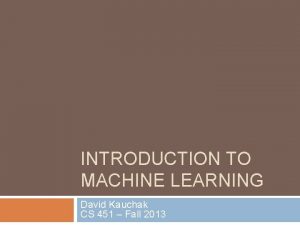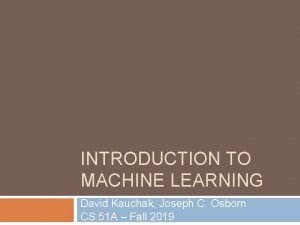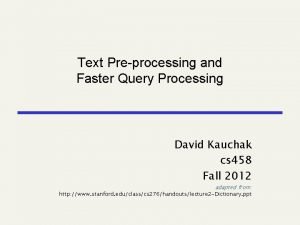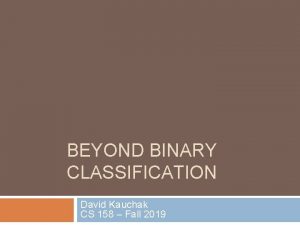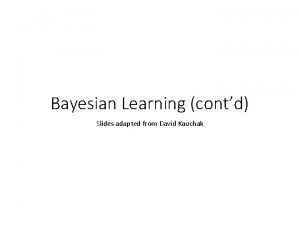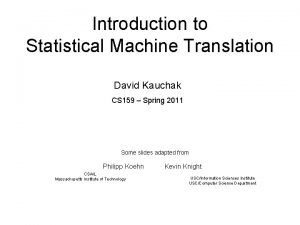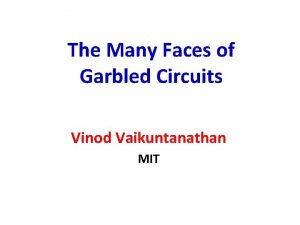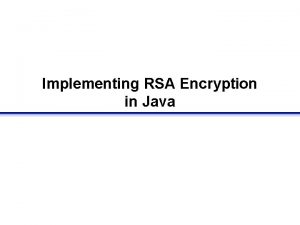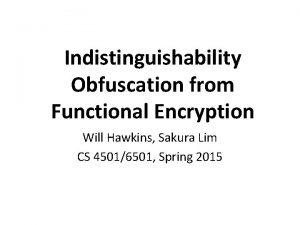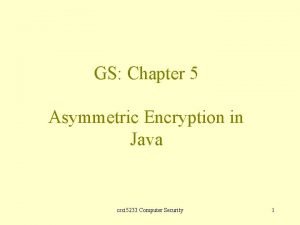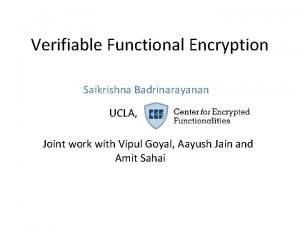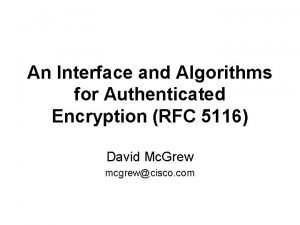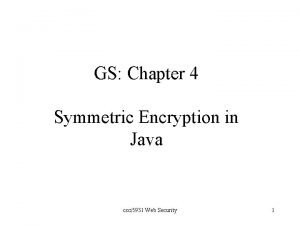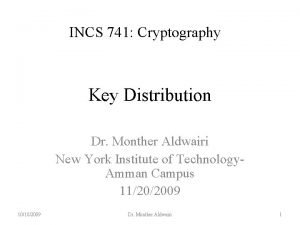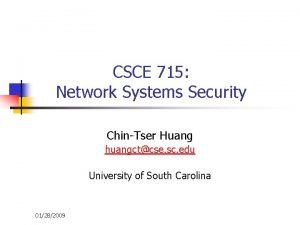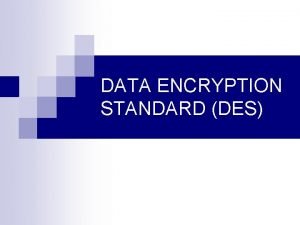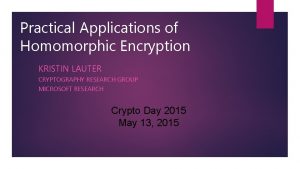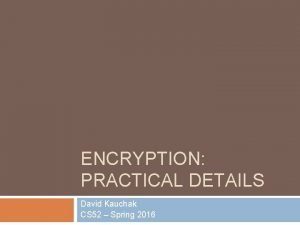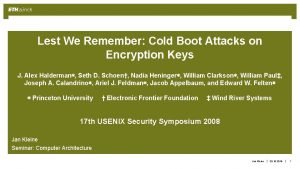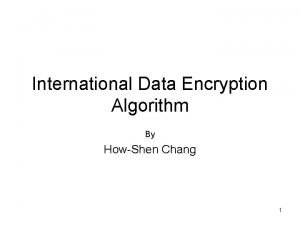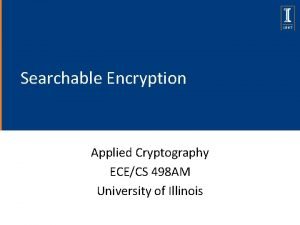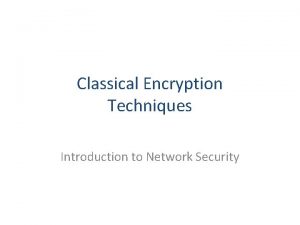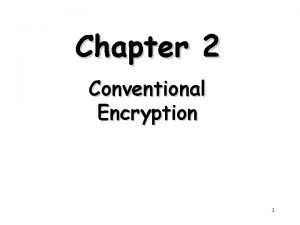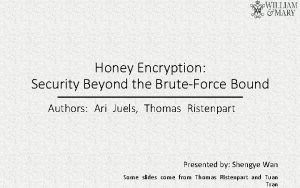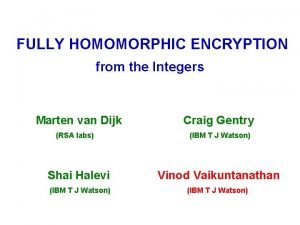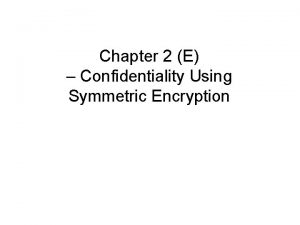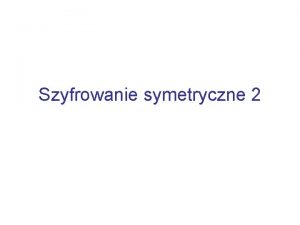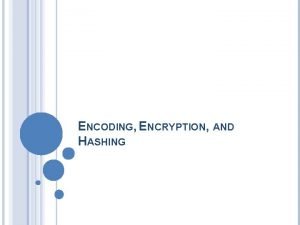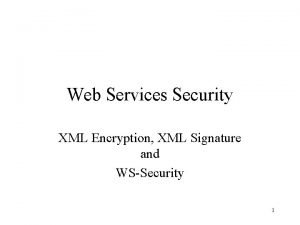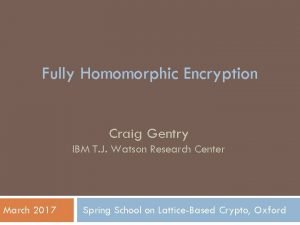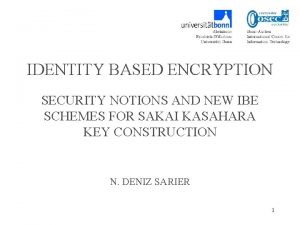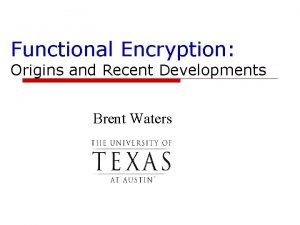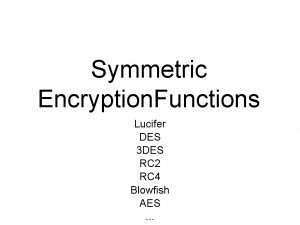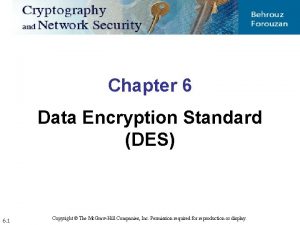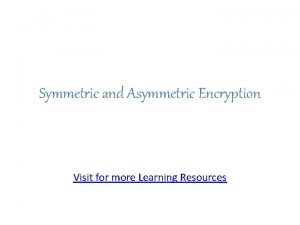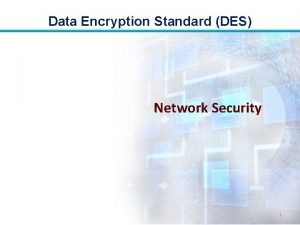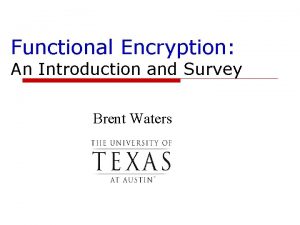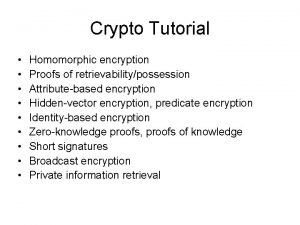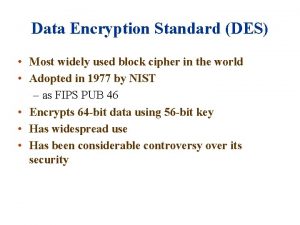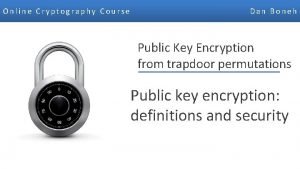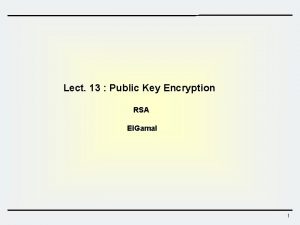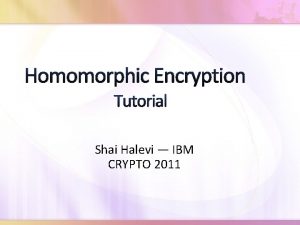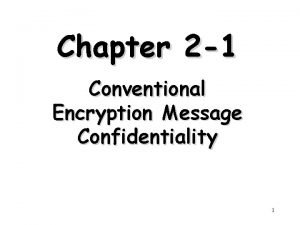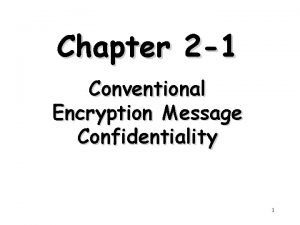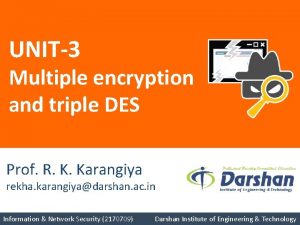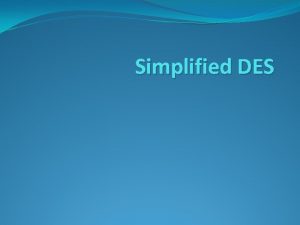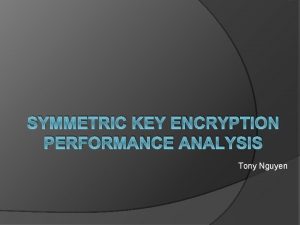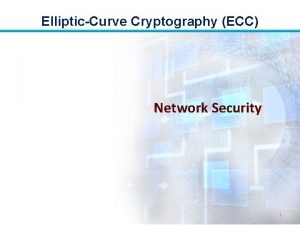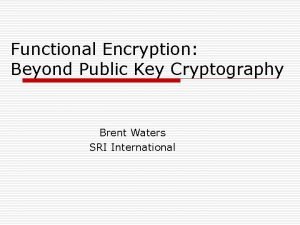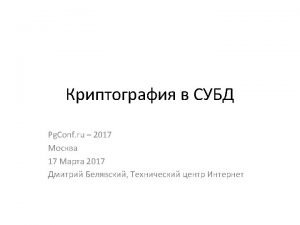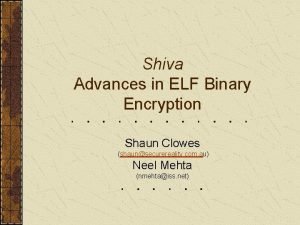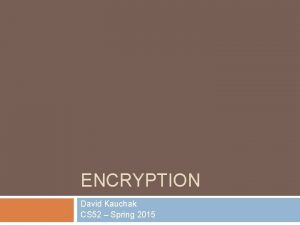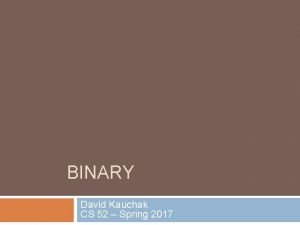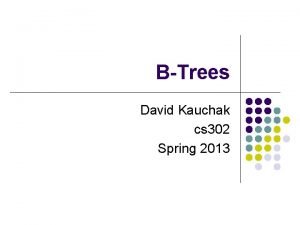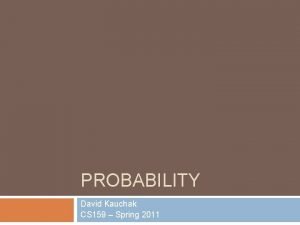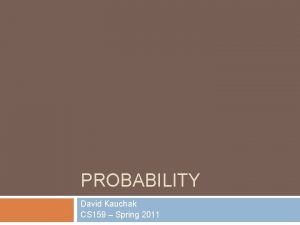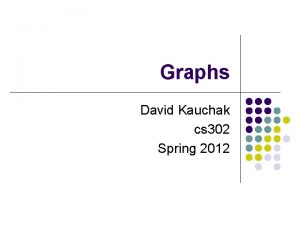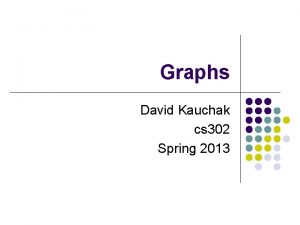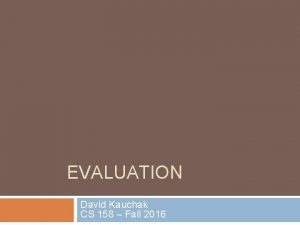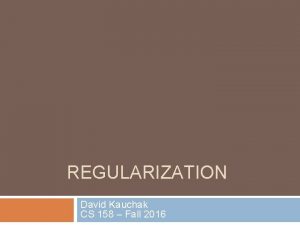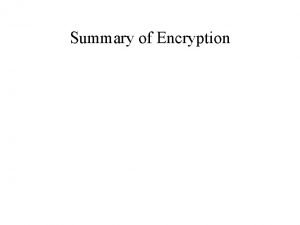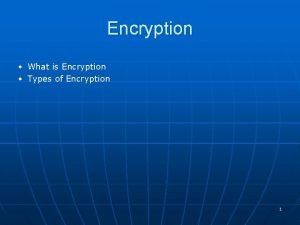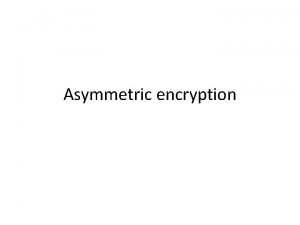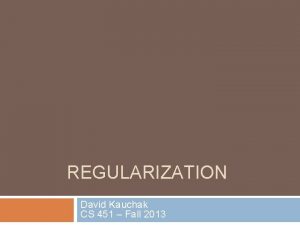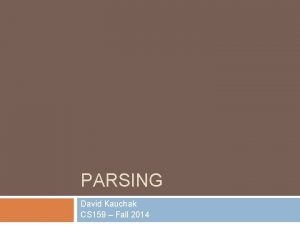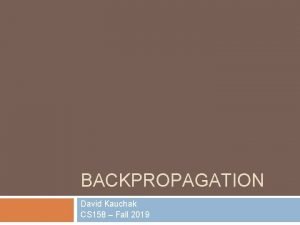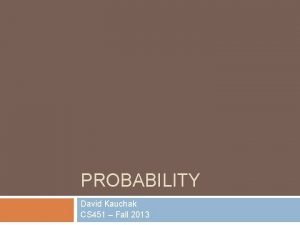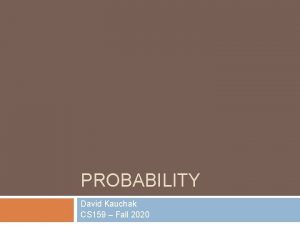ENCRYPTION David Kauchak CS 52 Spring 2016 Admin












































































- Slides: 76

ENCRYPTION David Kauchak CS 52 – Spring 2016

Admin Assignment 6

Survey: respondents 24 total respondents

Survey: “How is the class going? ”

Survey: “How is the difficulty of the class? ”

Survey: time spent per week

Survey: comments It's rewarding to get the right answers after putting in lots of effort Making my code work after hours of coding!! The feeling of relief/ success of turning in assignments

Survey: comments More opportunities for collaboration or at least a less pessimistic attitude towards discussing assignments with classmates.

Survey: comments Practice questions for every test so we can have a good idea of what to expect on the tests.

Survey: comments Having a CS 52 mixer would allow students and mentors to interact in a more social environment creating a stronger Pomona CS community. Although CS snack and the weekly lunch with Prof. Kauchak are good events, those are very defined and formal events to perform informal actions like getting to know someone else better. A mixer with all the sections would also allow non-Pomona students to meet new students. Libations optional.

Survey: comments Haskell>SML and what I mean by it's just going ok is that I think we could learn more

Survey: comments Releasing homework solutions after we complete them.

Survey: comments I have honestly enjoyed the midterms

Encryption What is it and why do we need it?

Encryption I like bananas

Encryption I like bananas

Encryption: a bad attempt I like bananas

Encryption: the basic idea I like bananas encrypt message decrypt message I like bananas send encrypted message

Encryption: a better approach the hawk sleeps at midnight

Encryption uses Where have you seen encryption used?

Encryption uses

Private key encryption I like bananas encrypt message decrypt message I like bananas send encrypted message

Private key encryption Any problems with this?

Private key encryption

Private key encryption ?

Public key encryption private key public key Two keys, one you make publicly available and one you keep to yourself

Public key encryption Share your public key with everyone

Public key encryption I like bananas encrypt message decrypt message I like bananas send encrypted message

Public key encryption Only the person with the private key can decrypt! decrypt message I like bananas

Modular arithmetic Normal arithmetic: a=b a is equal to b or a-b = 0 Modular arithmetic: a b (mod n) a-b = n*k for some integer k or a = b + n*k for some integer k or a % n = b % n (where % is the mod operator)

Modular arithmetic Which of these statements are true? 12 5 (mod 7) 52 92 (mod 10) 17 12 (mod 6) 65 33 (mod 32) a-b = n*k for some integer k or a = b + n*k for some integer k or a % n = b % n (where % is the mod operator)

Modular arithmetic Which of these statements are true? 12 52 17 65 5 (mod 7) 12 -5 = 7 = 1*7 12 % 7 = 5 % 7 92 (mod 10) 92 -52 = 40 = 4*10 92 % 10 = 2 = 52 % 20 12 (mod 6) 33 (mod 32) 17 -12 = 5 17 % 6 = 5 12 % 6 = 0 65 -33 = 32 = 1*32 65 % 32 = 1 = 33 % 32

Modular arithmetic properties If: a b (mod n) then: a mod n = b mod n “mod”/remainder operator congruence (mod n)

Modular arithmetic properties If: a b (mod n) then: a mod n = b mod n More importantly: (a+b) mod n = ((a mod n) + (b mod n)) mod n and (a*b) mod n = ((a mod n) * (b mod n)) mod n What do these say?

Modular arithmetic Why talk about modular arithmetic and congruence? How is it useful? Why might it be better than normal arithmetic? We can limit the size of the numbers we’re dealing with to be at most n (if it gets larger than n at any point, we can always just take the result mod n) The mod operator can be thought of as mapping a number in the range 0 … n-1

GCD What does GCD stand for?

Greatest Common Divisor gcd(a, b) is the largest positive integer that divides both numbers without a remainder gcd(25, 15) = ?

Greatest Common Divisor gcd(a, b) is the largest positive integer that divides both numbers without a remainder gcd(25, 15) = 5 Divisors: 25 15 25 5 1 15 5 3 1

Greatest Common Divisor gcd(a, b) is the largest positive integer that divides both numbers without a remainder gcd(100, 52) = ?

Greatest Common Divisor gcd(a, b) is the largest positive integer that divides both numbers without a remainder gcd(100, 52) = 4 Divisors: 100 52 100 50 25 20 10 5 4 2 1 52 13 4 2 1

Greatest Common Divisor gcd(a, b) is the largest positive integer that divides both numbers without a remainder gcd(14, 63) = ? gcd(7, 56) = ? gcd(23, 5) = ? gcd(100, 9) = ? gcd(111, 17) = ?

Greatest Common Divisor gcd(a, b) is the largest positive integer that divides both numbers without a remainder gcd(14, 63) = 7 gcd(7, 56) = 7 gcd(23, 5) = 1 gcd(100, 9) = 1 gcd(111, 17) = 1 Any observations?

Greatest Common Divisor When the gcd = 1, the two numbers share no factors/divisors in common If gcd(a, b) = 1 then a and b are relatively prime This a weaker condition than primality, since any two prime numbers are also relatively prime, but not vice versa

Greatest Common Divisor A useful property: If two numbers, a and b, are relatively prime (i. e. gcd(a, b) = 1), then there exists a c such that a*c mod b = 1

RSA public key encryption Have you heard of it? What does it stand for?

RSA public key encryption RSA is one of the most popular public key encryption algorithms in use RSA = Ron Rivest, Adi Shamir and Leonard Adleman

RSA public key encryption 1. Choose a bit-length k Security increases with the value of k, though so does computation 2. 3. Choose two primes p and q which can be represented with at most k bits Let n = pq and ϕ(n) = (p-1)(q-1) ϕ() is called Euler’s totient function 4. Find d such that 0 < d < n and gcd(d, ϕ(n)) = 1 5. Find e such that de mod ϕ(n) = 1 Remember, we know one exists!

RSA public key encryption p: prime number q: prime number n = pq ϕ(n) = (p-1)(q-1) d: 0 < d < n and gcd(d, ϕ(n)) = 1 e: de mod ϕ(n) = 1 Given this setup, you can prove that given a number m: (me)d = med = m (mod n) What does this do for us, though?

RSA public key encryption p: prime number q: prime number n = pq ϕ(n) = (p-1)(q-1) d: 0 < d < n and gcd(d, ϕ(n)) = 1 e: de mod ϕ(n) = 1 Given this setup, you can prove that given a number m: m message What does this do for us, though?

RSA public key encryption p: prime number q: prime number n = pq ϕ(n) = (p-1)(q-1) d: 0 < d < n and gcd(d, ϕ(n)) = 1 e: de mod ϕ(n) = 1 Given this setup, you can prove that given a number m: (me) encrypted message What does this do for us, though?

RSA public key encryption p: prime number q: prime number n = pq ϕ(n) = (p-1)(q-1) d: 0 < d < n and gcd(d, ϕ(n)) = 1 e: de mod ϕ(n) = 1 Given this setup, you can prove that given a number m: (me)d = med = m (mod n) What does this do for us, though? decrypted message

RSA public key encryption p: prime number q: prime number n = pq ϕ(n) = (p-1)(q-1) d: 0 < d < n and gcd(d, ϕ(n)) = 1 e: de mod ϕ(n) = 1 private key public key (d, n) (e, n)

RSA encryption/decryption private key public key (d, n) (e, n) You have a number m that you want to send encrypted encrypt(m) = me mod n (uses the public key) How does this encrypt the message?

RSA encryption/decryption private key public key (d, n) (e, n) You have a number m that you want to send encrypted encrypt(m) = me mod n (uses the public key) - Maps m onto some number in the range 0 to n 1 - If you vary e, it will map to a different number - Therefore, unless you know d, it’s hard to know

RSA encryption/decryption private key public key (d, n) (e, n) You have a number m that you want to send encrypted encrypt(m) = me mod n (uses the public key) decrypt(z) = zd mod n Does this work? (uses the private key)

RSA encryption/decryption encrypt(m) = me mod n decrypt(z) = zd mod n decrypt(z) = decrypt(me mod n) z is some encrypted message = (me mod n)d mod n definition of decrypt = (me)d mod n modular arithmetic = m mod n (me)d = med = m (mod n) Did we get the original message?

RSA encryption/decryption encrypt(m) = me mod n decrypt(z) = zd mod n decrypt(z) = decrypt(me mod n) z is some encrypted message = (me mod n)d mod n definition of decrypt = (me)d mod n modular arithmetic = m mod n If 0 ≤ m < n, yes! (me)d = med = m (mod n)

RSA encryption: an example p: prime number q: prime number n = pq p=3 q = 13 n=? ϕ(n) = ? d=? e=? ϕ(n) = (p-1)(q-1) d: 0 < d < n and gcd(d, ϕ(n)) = 1 e: de mod ϕ(n) = 1

RSA encryption: an example p: prime number q: prime number n = pq p=3 q = 13 n=? ϕ(n) = (p-1)(q-1) d: 0 < d < n and gcd(d, ϕ(n)) = 1 e: de mod ϕ(n) = 1

RSA encryption: an example p: prime number q: prime number n = pq p=3 q = 13 n = 3*13 = 39 ϕ(n) = (p-1)(q-1) d: 0 < d < n and gcd(d, ϕ(n)) = 1 e: de mod ϕ(n) = 1

RSA encryption: an example p: prime number q: prime number n = pq p=3 q = 13 n = 39 ϕ(n) = ? ϕ(n) = (p-1)(q-1) d: 0 < d < n and gcd(d, ϕ(n)) = 1 e: de mod ϕ(n) = 1

RSA encryption: an example p: prime number q: prime number n = pq p=3 q = 13 n = 39 ϕ(n) = 2*12 = 24 ϕ(n) = (p-1)(q-1) d: 0 < d < n and gcd(d, ϕ(n)) = 1 e: de mod ϕ(n) = 1

RSA encryption: an example p: prime number q: prime number n = pq p=3 q = 13 n = 39 ϕ(n) = 24 d=? e=? ϕ(n) = (p-1)(q-1) d: 0 < d < n and gcd(d, ϕ(n)) = 1 e: de mod ϕ(n) = 1

RSA encryption: an example p: prime number q: prime number n = pq p=3 q = 13 n = 39 ϕ(n) = 24 d=5 e=5 ϕ(n) = (p-1)(q-1) d: 0 < d < n and gcd(d, ϕ(n)) = 1 e: de mod ϕ(n) = 1

RSA encryption: an example p: prime number q: prime number n = pq p=3 q = 13 n = 39 ϕ(n) = 24 d=5 e = 29 ϕ(n) = (p-1)(q-1) d: 0 < d < n and gcd(d, ϕ(n)) = 1 e: de mod ϕ(n) = 1

RSA encryption: an example n = 39 d=5 e = 29 encrypt(m) = me mod n decrypt(z) = zd mod n encrypt(10) = ?

RSA encryption: an example n = 39 d=5 e = 29 encrypt(m) = me mod n decrypt(z) = zd mod n encrypt(10) = 1029 mod 39 = 4

RSA encryption: an example n = 39 d=5 e = 29 encrypt(m) = me mod n decrypt(z) = zd mod n encrypt(10) = 1029 mod 39 = 4 decrypt(4) = ?

RSA encryption: an example n = 39 d=5 e = 29 encrypt(m) = me mod n decrypt(z) = zd mod n encrypt(10) = 1029 mod 39 = 4 decrypt(4) = 45 mod 39 = 10

RSA encryption: an example n = 39 d=5 encrypt(m) = me mod n decrypt(z) = zd mod n encrypt(2) = ?

RSA encryption: an example n = 39 d=5 encrypt(m) = me mod n decrypt(z) = zd mod n encrypt(2) = 25 mod 39 = 32 decrypt(32) = ?

RSA encryption: an example n = 39 d=5 encrypt(m) = me mod n decrypt(z) = zd mod n encrypt(2) = 25 mod 39 = 32 decrypt(32) = 325 mod 39 = 2

RSA encryption in practice For RSA to work: 0 ≤ m < n What if our message isn’t a number? What if our message is a number that’s larger than n?

RSA encryption in practice For RSA to work: 0 ≤ m < n What if our message isn’t a number? We can always convert the message into a number (remember everything is stored in binary already somewhere!) What if our message is a number that’s larger than n? Break it into n sized chunks and encrypt/decrypt those chunks

RSA encryption in practice encrypt(“I like bananas”) = 0101100101011100 … encode as a binary string (i. e. number 4, 15, 6, 2, 22, … break into multiple < n size numbers 17, 1, 43, 15, 12, … encrypt each number

RSA encryption in practice decrypt((17, 1, 43, 15, 12, …)) = 4, 15, 6, 2, 22, … decrypt each number 0101100101011100 … put back together “I like bananas” turn back into a string (or whatever the original message was) Often encrypt and decrypt just assume sequences of bits and the interpretation is
 David kauchak
David kauchak David kauchak
David kauchak David kauchak
David kauchak David kauchak
David kauchak David kauchak
David kauchak David kauchak
David kauchak David kauchak
David kauchak Introduction to teaching 6th edition
Introduction to teaching 6th edition Spring summer fall winter and spring cast
Spring summer fall winter and spring cast Spring fall summer winter
Spring fall summer winter Symantec endpoint encryption
Symantec endpoint encryption What are these
What are these Rsa algorithm java
Rsa algorithm java Microsoft rsa encryption
Microsoft rsa encryption Functional encryption
Functional encryption Gpon power budget calculation
Gpon power budget calculation Asymmetric encryption java
Asymmetric encryption java Saikrishna badrinarayanan
Saikrishna badrinarayanan Aes des
Aes des Homomorphic encryption standard
Homomorphic encryption standard Rfc 5116
Rfc 5116 Java symmetric encryption
Java symmetric encryption Ecommerce vocabulary
Ecommerce vocabulary Placement of encryption function in cryptography
Placement of encryption function in cryptography Encryption
Encryption Data encryption standard history
Data encryption standard history Applications for homomorphic encryption
Applications for homomorphic encryption Encryption
Encryption Lest we remember: cold boot attacks on encryption keys
Lest we remember: cold boot attacks on encryption keys Classical encryption techniques in cryptography
Classical encryption techniques in cryptography Block ciphers and the data encryption standard
Block ciphers and the data encryption standard International data encryption algorithm
International data encryption algorithm Searchable symmetric encryption
Searchable symmetric encryption Classical encryption techniques in network security
Classical encryption techniques in network security Azure sql encryption in transit
Azure sql encryption in transit What is conventional encryption
What is conventional encryption Decrypt
Decrypt Homomorphic encryption
Homomorphic encryption Confidentiality with symmetric encryption
Confidentiality with symmetric encryption Homomorphic encryption
Homomorphic encryption Szyfrowanie symetryczne
Szyfrowanie symetryczne Encoding encryption and hashing
Encoding encryption and hashing Xml encryption in web services
Xml encryption in web services Craig gentry ibm
Craig gentry ibm Functional encryption
Functional encryption Functional encryption
Functional encryption Hdfs transparent encryption
Hdfs transparent encryption Lucifer encryption
Lucifer encryption Des encryption example
Des encryption example Asymmetric key cryptography
Asymmetric key cryptography Craig gentry homomorphic encryption
Craig gentry homomorphic encryption Des in information security
Des in information security Functional encryption
Functional encryption Homomorphic encryption tutorial
Homomorphic encryption tutorial Des initial permutation calculator
Des initial permutation calculator Rsa trapdoor permutation
Rsa trapdoor permutation 2 way encryption php
2 way encryption php Rsa el
Rsa el Azure server side encryption
Azure server side encryption Homomorphic encryption tutorial
Homomorphic encryption tutorial Order revealing encryption
Order revealing encryption Conventional encryption and message confidentiality
Conventional encryption and message confidentiality Voltage securemail on-premise
Voltage securemail on-premise Conventional encryption model
Conventional encryption model Homomorphic encryption tutorial
Homomorphic encryption tutorial Row level encryption
Row level encryption Encryption
Encryption Multiple encryption and triple des
Multiple encryption and triple des Sdes in cryptography
Sdes in cryptography Rsa vs aes performance
Rsa vs aes performance Encryption decrypti
Encryption decrypti Trusted content services
Trusted content services Functional encryption
Functional encryption Symmetric key distribution using asymmetric encryption
Symmetric key distribution using asymmetric encryption Pgcrypto
Pgcrypto What is encryption
What is encryption Encryption
Encryption
